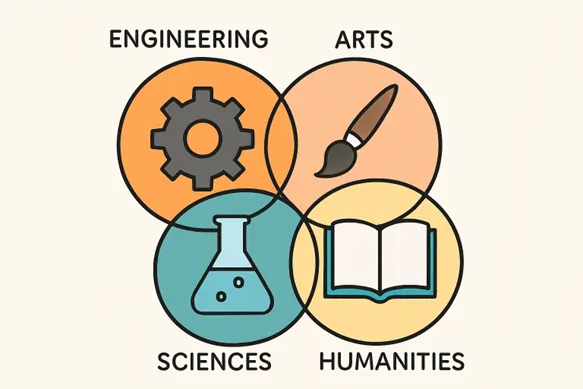Why Multidisciplinary Learning Matters
The traditional boundaries between academic disciplines are rapidly blurring. Employers, educators, and students are recognizing the necessity for more interconnected approaches to learning. At the forefront of this shift are educational programs and institutions that actively promote cross-pollination between sciences, humanities, arts, and technology. Prospective students exploring their options can discover a diverse spectrum of customized paths at las.illinois.edu, which is at the cutting edge of innovative multidisciplinary education.
Shifting from specialization to multidisciplinary study is not just a trend—it’s a reflection of the ever-changing demands of the job market and society. According to a recent analysis from U.S. News & World Report, employers are increasingly drawn to graduates who demonstrate the ability to integrate ideas from multiple disciplines. This broad perspective helps organizations remain competitive and innovative.
Key Takeaways
- Multidisciplinary studies are redefining both higher education and career preparation.
- Employers increasingly value graduates who can bridge knowledge across disciplines.
- Students exposed to a range of subjects tend to develop stronger critical thinking skills.
- Real-world issues often require solutions that draw from multiple academic fields.
- Access to multidisciplinary education can improve creativity and adaptability in the job market.
Historical Roots of Multidisciplinary Approaches
Multidisciplinary education may seem modern, but its origins stretch back centuries. Ancient educational systems often combined philosophy, mathematics, rhetoric, and sciences, nurturing well-rounded thinkers. The practice of blending fields continued through the Renaissance, when polymaths like Leonardo da Vinci flourished by drawing on an array of subjects. Today, as noted by The Chronicle of Higher Education, universities are reinvigorating this tradition by blending liberal arts with STEM, business, and social sciences. These historical roots underscore the value of connecting diverse knowledge streams for holistic understanding and transformative innovation.
Benefits of Multidisciplinary Studies
- Adaptability: Graduates accustomed to diverse coursework seamlessly transition between different roles or industries, an increasingly valuable asset in a rapidly evolving economy.
- Enhanced Problem-Solving: Tackling real-world challenges often requires insights from various fields. Multidisciplinary students develop the skills to approach issues creatively and collaboratively.
- Broader Perspective: By engaging with numerous subjects, students learn to appreciate multiple viewpoints, helping to avoid tunnel vision and surface more innovative solutions.
- Communication Skills: Bridging fields means communicating across specialized vocabularies and concepts, enhancing teamwork and the ability to articulate complex ideas clearly.
Student Voices: Real-World Learning
Student feedback consistently highlights the numerous tangible benefits of participating in multidisciplinary programs that integrate multiple fields of study. Many students find these collaborative environments to be more engaging and intellectually stimulating than traditional, single-discipline courses. For example, one student who paired data science with global history shared how analyzing population trends within cultural contexts sparked unique and unforeseen research questions, encouraging deeper critical thinking. Others report that exposure to multiple disciplines not only broadens their perspectives but also ignites new passions and interests, giving them a stronger sense of purpose and direction for their academic and professional futures. Not only does this multidisciplinary approach boost motivation and enthusiasm, but it also fosters the kind of curiosity, creativity, and problem-solving skills that drive innovation, lifelong learning, and adaptability in an ever-changing world.
How It Shapes Career Readiness
The modern workplace demands much more than technical expertise. According to the National Association of Colleges and Employers, critical thinking, adaptability, and the ability to connect ideas between domains are among the most sought-after skills. Recent surveys underscore these priorities:
- 83% of hiring managers list problem-solving as a top skill for applicants.
- 70% of posted jobs now require skills that bridge at least two traditional academic areas.
This shift reflects the need to address complex problems, manage dynamic teams, and stay innovative amid constant change. Graduates who embrace multidisciplinary learning are prepared to lead, not just adapt, in such environments.
Practical Examples in Today’s Workforce
The impact of multidisciplinary education is evident across a range of industries. For instance, product design teams often include engineers, psychologists, and artists who collaborate to optimize user experience from every angle. In healthcare, professionals with combined backgrounds in biology, policy, and engineering are working together to deliver more comprehensive patient care. Environmental science is another arena where solutions demand expertise in policy, technology, and environmental biology, exemplifying the value of interdisciplinary teams.
Even major corporations are restructuring around multidisciplinary teams to spur innovation. As highlighted by The New York Times, businesses that cultivate talent able to synthesize insights from various departments are seeing more resilient, creative, and effective results.
Challenges and Balancing Acts
Despite the clear advantages, multidisciplinary education is not without challenges. A major concern is avoiding knowledge gaps or superficial understanding in critical areas. Successful programs safeguard against this by integrating in-depth learning experiences such as capstone projects, internships, and research opportunities. Some critics fear expertise will be diluted, but comprehensive curricula can foster both breadth and depth. The result is students who are not just generalists but flexible, insightful problem-solvers.
Looking Ahead: The Future of Multidisciplinary Education
The rise of automation, artificial intelligence (AI), and increasingly globalized work environments signals a growing need for versatile knowledge and skills among future professionals. In response, universities are proactively redesigning degree programs to encourage students to mix and match courses across traditional academic boundaries, fostering interdisciplinary learning. Furthermore, more students are creating individualized majors tailored to their specific interests, career ambitions, and emerging industry trends, thereby laying a solid foundation for resilience and adaptability in an unpredictable, rapidly changing job market. As reported by Inside Higher Ed, this wave of educational innovation is not only preparing students to effectively respond to rapid change and technological evolution but also empowering them to become drivers of change within their respective fields and society at large.
Conclusion
Embracing multidisciplinary study, which involves integrating knowledge and methods from multiple disciplines, equips students and professionals alike with the creativity, adaptability, innovative thinking, and problem-solving skills demanded by today’s rapidly changing and highly competitive world. As industries and educational institutions continue to evolve and adapt to new technologies and global challenges, the ability to bridge fields, synthesize diverse perspectives, and think critically will remain at the very core of enduring success and growth. Learners who pursue these flexible, integrated, and forward-looking pathways today will be the best prepared for the numerous opportunities and complex challenges that tomorrow’s ever-shifting, interconnected landscape will present.
Read more: Top SEO Strategies Every eLearning Company Should Use – Croudmomentum.com
How to Create a Website with AI: A Guide – Croudmomentum.com
How to Treat Keratosis Pilaris: Best KP Exfoliating Lotions and Skincare Tips – Croudmomentum.com








